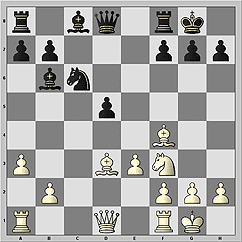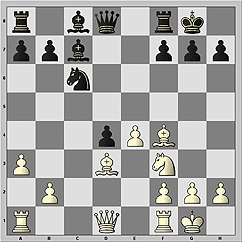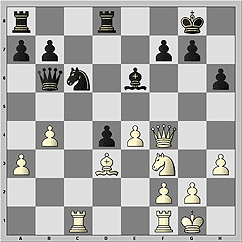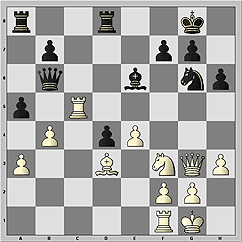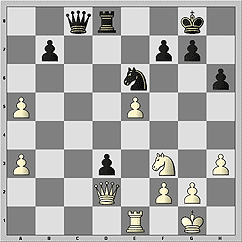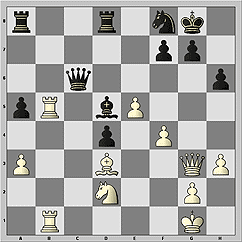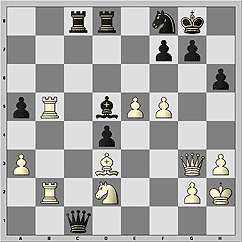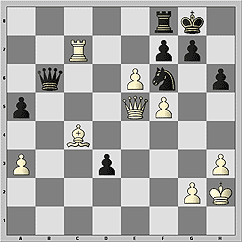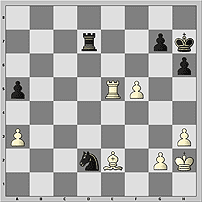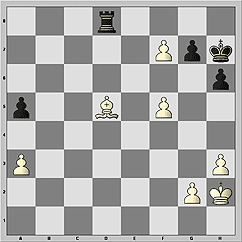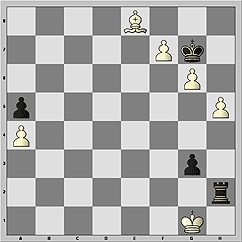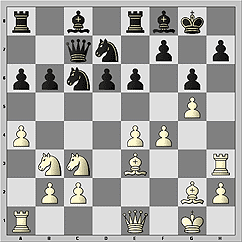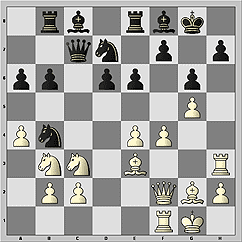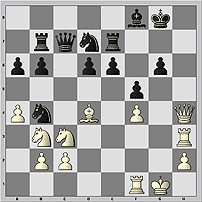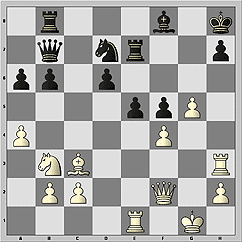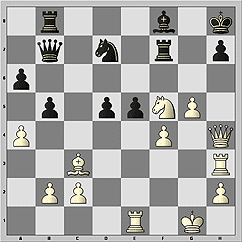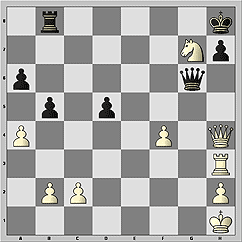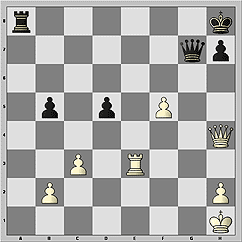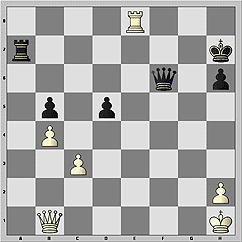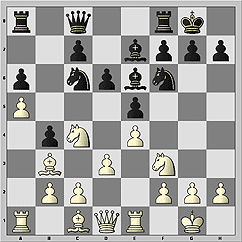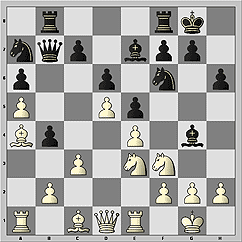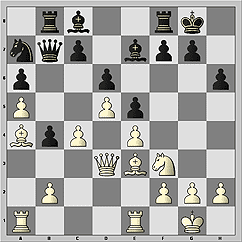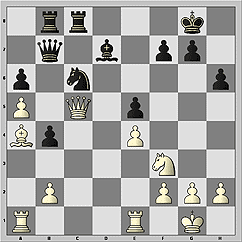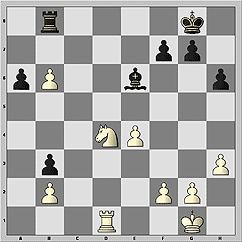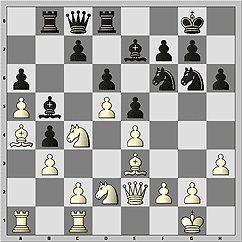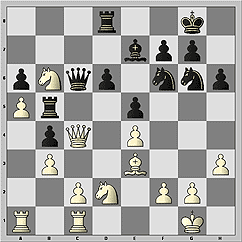 | Последние турниры |
Чемпионат России
СуперФинал

02.12.2006
Суперфинал чемпионата России проходит в Москве, в ЦДШ им. М.М.Ботвинника со 2 по 15 декабря при 12 участниках по круговой системе.
Крамник - Fritz

25.11.2006
С 25 ноября по 5 декабря в Бонне чемпион мира Владимир Крамник сыграет матч из 6 партий с программой Deep Fritz. В случае победы Крамник получит 1 миллион долларов, тем самым удвоив свой стартовый гонорар ($500000).
Мемориал Таля

5.11.2006
В Москве с 5 по 19 ноября проходил Мемориал Таля, в программе которого супертурнир 20-й категории и выдающийся по составу блицтурнир. Призовой фонд каждого состязания - 100.000 долларов.
Топалов - Крамник

23.09.2006
После того как "основное время" не выявило победителя (счет 6:6), 13 октября соперники сыграли 4 дополнительных поединка с укороченным контролем времени.
Томск. Высшая лига

2.09.2006
Со 2 по 11 сентября Томск принимает Высшую лигу чемпионата России 2006 года. В турнире участвуют 58 шахматистов - как получившие персональные приглашения, так и победившие в отборочных состязаниях.
Майнц

17.08.2006
В последние годы фестиваль в Майнце вслед за "Амбер-турниром" стал центром легких шахматных жанров. Наряду с массовыми ристалищами традиционно проходят чемпионские дуэли.
Россия - Китай

10.08.2006
С 10 по 20 августа в Китае проходит товарищеский матч сборных России и Китая. В нынешнем поединке как мужчины, так и женщины соревнуются на пяти досках по шевенингенской системе в два круга.
Все материалы
ChessPro

|
|

|
|
 |
By grandmaster
Sergey SHIPOV |
Si vis pacem, para bellum! |
“If you want peace prepare war” a well-known Latin expression says. Actually, it is the best motto for those chess players who are OK in a particular tournament situation. One should never purposely play for a draw!
It is particularly important for aggressive, attacking players. Betraying one’s own credo, self-limitation and constraint are fraught with sad consequences. Tournament practice illustrated it on many occasions. To reach any positive outcome one should play his or her own chess, play as you can!
Veselin Topalov, who is leading the field with an impressive margin, strictly follows this rule. He fights for victory in every game, runs risks, maintain tension on the board. The lady-luck has guarded Veselin so far. As all ladies she likes brave guys!
As for of the tournament itself, the players look very tired. It is noticeable even from the distance; the games speak for themselves very eloquently. Since Vishy Anand gave up his ambitions, he has no desire to play every game all out. To their credit, Svidler and Morozevich keep fighting, but to no effect. Human energy is limited.
Judit Polgar completely fell through. It is pity to see this excellent player at the bottom of the standings. Her poor shape is aggravated by insufficient opening preparation. It does not meet the high standards of the event.
The Muscovite wins in San Luis in his trademarked style. This approach has been known for a century; the first person that came to my mind is the great Emmanuel Lasker. Alexander creates complicated, strategically risky position and incites his opponents to active operations. When the opponent launches an attack (most often it happens closer to the time trouble) Alexander mount a very resourceful defense! As a result the opponent commits a mistake, the position drastically changes, Morozevich intercepts the initiative and closes out the game. The trick did not work this time though. The chess fakir was lucky enough to avoid the defeat. Even in this game his agility in wielding the pieces impresses. Alexander juggle with elegance – hides an ace and quickly takes it out from the sleeve!
Queen’s Gambit D37
Veselin TOPALOV (BUL) – Alexander MOROZEVICH (RUS)
1.d4 Nf6 2.c4 e6 3.Nf3 d5 4.Nc3 Be7 5.Bf4 0–0 6.e3 c5 7.dxc5 Bxc5 8.a3 Nc6 9.cxd5 Nxd5 10.Nxd5 exd5 11.Bd3 Bb6 12.0–0. The opponents played a well-known and deeply analyzed variation of the Queen’s Gambit.
12...d4! A subtle psychological approach. Sasha fully realized that Veselin was up to a real fight and thus would not trade pieces on d4. The popularity of 12...Bg4 drastically decreased after a well-known game Kramnik – Leko (Bressago, 2004) which went 13.h3 Bh5 14.b4 Re8 15.Rc1 a6 16.Bxa6! Rxa6 17.b5 Rxa3 18.bxc6 bxc6 19.Rxc6 Ra7 20.Rd6 Rd7 21.Qxd5 Rxd6 22.Qxd6 Qxd6 23.Bxd6 and here Vladimir probably should not have traded his f3-bishop. For example Vishy managed to hold this endgame against Karpov in 2002. One way or another no one wants to go for such unpromising variation on the black side.
13.e4! After 13.exd4 Nxd4 14.Be5 Nc6 15.Bc3 Bg4 16.h3 Bh5 17.Be4 Re8 18.Qc2 Bg6 19.Bxg6 hxg6 20.Rad1 Qe7 a boring roughly equal position arouse (Gustaffson – Kasimdzhanov, Germany 2004).
13...Bc7. That is a novelty. It is really strange that no one came up with this such a natural move. Black is trading his passive bishop.
There are 53 games in which this position emerged in my database. All the encounters saw Black play 13...Bg4. Here is a fresh example: 14.h3 Qf6 15.Bg3 Bh5 16.Re1 Rfe8 17.Rc1 Bxf3 18.Qxf3 Ne5 19.Qxf6 gxf6 20.Bxe5 fxe5 21.g3. White obtained a slight edge in the endgame but did not manage to convert it (Christiansen – Onischuk, Minneapolis 2005).
14.Bxc7 Qxc7 15.h3 Qb6 (the continuation 15...a5 fails to 16.Bc4; on the other hand 15...Be6!? deserves a closer look because on 16.Ng5 there is a good reply 16...Ne5) 16.b4 Be6 17.Rc1! White has no reason to calculate the complications after 17.Ng5 Ne5! 18.Nxh7 Nxd3 19.Nxf8 Bc4 20.Qc2 (or 20.Nd7 Qe6 21.Qc2 Nf4!) 20...Rc8 21.Nd7 Qe6 22.Rfd1 Nf4 23.Nc5 Qg6 24.g3 Be2! – Black has a very strong attack here. By the way, Black has a strong positional rejoinder at his disposal – 18... Rfd8 (instead of capturing on) 19.Ng5 Rac8, and the d6-pawn is set to start its triumphant march.
17...h6 18.Qd2 Rfd8 19.Qf4! The black king is in jeopardy. White is going to send his queen to h7 with e4-e5 и Qf4-e4. I think it is about time to review the opening results. Black failed to equalize!
19...Ne7! 20.Rc5. It is not a mistake but a mere introduction to the error. A simple centralizing move 20.Rfd1!? looks very solid. After the c6-knight retreat d4-pawn is very vulnerable.
20...Ng6 21.Qg3?! White does not feel the danger. He should have played 21.Qd2 although after 21...Rac8 22.Rfc1 Rxc5 23.Rxc5 Qd6! Black is just in time to build a firm line of defense.
21...a5! Powerful blow! Owing to the rook’s position on c5 Black managed to open the position on the queenside having avoided the b4-b5 clamping up. Judging from Veselin’s long reflections he realized all the dangers only after Black’s 21st move.
22.Rb5 (after 22.e5 axb4 23.axb4 Nf8! Black has a strong initiative) 22...Qc6 23.e5. In case of 23.bxa5 Qc3 24.Rd1 Rxa5 (24...Bb3 25.Rd2!) 25.Rxb7 Bb3! Black faces serious problems as 26.Rd2 fails to 26...Ne5!
23...b6. I think better was 23...Bf5! 24.Rc5 Qe6 или 24...Qd7, forcing black to raise the blockade of the d4-pawn. For example 25.Bxf5 Qxf5 26.bxa5 Rac8! 27.Rxc8 Qxc8 28.Re1 Nf8 29.Qf4 Ne6 30.Qd2 d3
Black has a powerful initiative for the pawn. White has no other choice but to struggle for survival.
24.bxa5 bxa5 25.Rfb1 (finally, White managed to coordinate his rooks) 25...Nf8 26.Nd2! (White is going to transfer his knight to e4) 26...Bd5! (whereas Black’s knight is heading to e6) 27.f4!
That is Topalov’s style. Veselin does not like holing up in defense. He prefers head-on fight. Possible weaknesses in his own camp never abash the Bulgarian GM.
27...Qc3 (the black knight’s bringing into play is postponed in view of 27...Ne6?! 28.f5! Ng5 – 28...Nc5 29.Rc1 – 29.h4 и т.д.) 28.R1b2. that is an interesting way to guard his pieces against the exchanges. After 28.Rxd5 should not capture on mechanically capture on – 28...Rxd5?! 29.Ne4! Qc6 30.Nf6+ Kh8 31.Nxd5 Qxd5 32.f5 – as White has a strong initiative here. He should proceed with 28...Qxd2! with a better position.
28...Qc1+! An interesting position arises in the line 28...Ng6 29.Rc2 Qxa3 30.Kh2! a4 (30...Nxf4? 31.Bh7+) 31.Rcc5 (31.f5? Nxe5!) 31...Qa2 32.Rc2 Qa3 33.Rcc5 – neither party can avoid repetition.
29.Kh2 Rac8 (Black warded off the Rb2-c2 threat; now his rook can settle down on the c3-square) 30.f5. Counterattack is the only defense here! Alexander hastened at this point.
30...Rc3?! Much better was 30...a4!, creating an outpost on b3. In this Black’s bishop can immediately take up this square separating White’s rooks. The lunge Rc8-c3 is possible in some lines. On Nd2-b1 Black has a good rejoinder Rc3-b3! 31.f6 g6.
31.Nb1 (probably this “ugly” move came as an unpleasant surprise to the Muscovite) 31...Rc5. In case of 31...Rc6 the transfer of the white rook 32.Re2!? looks very strong. The e5-e6 breakthrough becomes a real threat. On the other hand there is no clear win in sight: 32...Bc4! 33.Re1 Bxb5 34.Rxc1 (34.Bxb5 Qc5 35.Bxc6 Qxc6) 34...Rxc1 35.e6 (35.Bxb5 Rxb1 36.Bc4 Rc1 37.Bb3) 35...Bxd3 (35...fxe6? 36.Bxb5 Rxb1 37.f6+–) 36.e7 Re8 37.exf8Q+ Kxf8 38.Qxd3 Ree1! 39.f6! Rxb1 40.Qxd4 gxf6 41.Qxf6 Re6 42.Qd8+ Kg7 43.Qxa5 – this endgame is drawing.
32.Rxc5 Qxc5 33.Rc2 Qb6 34.Nd2! (34.e6 fxe6 35.Rc7 fails to 35...Rd7!) 34...Re8? Apparently Morozevich was upset with this unexpected turn of events. To make things worse Alexander was in time trouble. As a result White made a serious mistake. After 34...Qb8 35.Rc5 Qb6 36.Rb5 Qc7 White gets an upper hand, but there is a lot of fight.
35.e6! (now Black is unable to protect his seventh rank) 35...Nh7 (35...fxe6 36.Rc7+–) 36.Rc7 Rf8 (36...Ng5 37.h4!) 37.Nc4! It took this passive knight just to jumps to become very active.
37...Bxc4 (after 37...Qb8 38.e7 Re8 39.Nd6! Qxc7 40.Nxe8 Qxg3+ 41.Kxg3 Bc6 42.Nd6 Nf6 43.Bc4 Black can resign with unclouded conscience) 38.Bxc4 Nf6 39.Qe5! d3.
40.exf7+. This time trouble decision is quite understandable. There is a well-known practical rule that reads: If you have the choice between a checkmate combination and an extra pawn, choose the latter, as there might be no checkmate! Veselin followed this rule but complicated his task. The shortest winning path was 40.e7! Re8 41.Bxd3 – threatening with Bd3-b5, whereas the counterblow 41...Nd5 fails to 42.Rc8! Rxc8 (42...Nf6 43.Qxf6!) 43.e8Q+ Rxe8 44.Qxe8+ Kh7 45.f6+ g6 46.Qxf7+ Kh8 47.Qg7#.
40...Kh7 41.Bxd3. Certainly White has a winning position. However in order to capitalize on his advantage White should make several accurate moves. It looks like Veselin relaxed a little bit lost concentration whereas Alexander pulled himself together and defended with devilish resourcefulness.
41...Qb3 42.Qd6 (42.Qe7! Qb8 43.Kh1+–) 42...Qb8! 43.Bc4 Ne4! 44.Qe5 (44.Qe7! Nd2 – 44...Rc8 45.f8N+! – 45.Bd3+–) 44...Nd2! Now Black has some problem-like saving ideas. The tandem queen + knight is very effective.
45.Ba2. Had Veselin anticipated what he was in for he would have gladly “blundered” a pawn with 45.Bd3! Rxf7 46.Re7 (or 46.f6+ Kg8 47.Re7 Qxe5+ 48.Rxe5 Rxf6 49.Rxa5 – White’s remote passer decides the game as White’s bishop is much stronger that Black’s knight.) 46...Qxe5+ 47.Rxe5 Rd7 48.Be2!
The a5-pawn is weak; the black king is in the checkmate box. Neither Lord nor Devil can help Black to save this endgame.
45...Qb6! (Black has created the threat 46...Nf3+! followed by perpetual.) 46.Rc2? Not as convincing was 46.Qc5 Qb2 as 47.Qc2? is met by 47...Qe5+. On the other hand 46.Rc5! was the simplest solution. Black can’t get to the white king. On 46...Ne4 White coolly reacts with 47.Rc2!
46...Qf2! 47.Rxd2 (Black has to annihilate Black’s dangerous knight 47.Kh1 Qf1+ 48.Kh2 Qf2!) 47...Qxd2 48.Bd5 Qg5! Here White is win is questionable.
49.Qd6 Qd8 50.Qxd8 Rxd8.
51.Bc6 (after 51.Kg3?! g5! 52.fxg6+ Kg7! 53.Be4 Rd4 54.Kf4 Ra4 55.Ke5 Rxa3 that is White who has to think about salvation. Actually it is still there – 56.Kd6 Re3 57.Bc6 and so on) 51...g6! One step farther 51...g5? would be a fatal mistake in view of 52.f6 Rf8 53.Be4+! Kh8 54.Bg6! – the black king is in captivity. He can’t do anything against his white colleague’s visit to e7.
52.Be8. In the course of the game I thought that there was a win for White in the line 52.f6 Rf8 53.Be8 (the sequence 53.Bd5 h5! 54.h4 g5 55.hxg5 Kg6 is dangerous only for White) 53...g5 54.Kg3 Kg6 55.Kf3 Kxf6 56.Ke4
However, the following analysis disprove my assumption: 56...Rh8 57.Kd5 h5 58.Kc5 Ke7 59.Kb5 Rh6 60.Kxa5 Rf6 61.a4 Rf2 62.Bc6 (62.g4 Rf3) 62...Kxf7 63.Kb6 Rb2+ 64.Kc7 Ke7 (64...Ra2? 65.Bd5+) 65.a5 Ra2 66.Kb6 Rb2+ 67.Kc7 (67.Bb5 Rxg2 68.a6 Ra2 69.a7 Rxa7=) 67...Ra2 68.Kb6 Rb2+ a draw by repetition.
52...Kg7 53.fxg6 h5! (preventing possible advancement of White’s pawns) 54.a4 (or 54.h4 Rd4 55.g3 Rg4 56.Kg2 Kf8 57.Kf3 Rxg6=) 54...h4! 55.Kg1 Rd2 56.g3! White is fighting to the last soldier!
56...hxg3 57.h4 Rh2 58.h5.
58...Kf8! (avoiding the last mine: 58...Rxh5? 59.f8Q+! Kxf8 60.g7+ Kxg7 61.Bxh5+–) 59.Kf1 Kg7 60.Kg1 Kf8 61.Kf1. Draw!
I think, we should thank both GMs for this very interesting, pithy encounter.
Rustam managed to take revenge. Although his redemption was not as spectacular as Judit’s victory, he leveled the score in their micro-match.
Sicilian Defense B83
Rustam KASIMDZHANOV (UZB) – Judit POLGAR (HUN)
1.e4 c5 2.Nf3 d6 3.d4 cxd4 4.Nxd4 Nf6 5.Nc3 a6 6.Be2 e6. Sheveningen variation.
7.a4 Be7 8.0–0 Nc6 9.Be3 0–0 10.f4 Bd7 (this move order is the most popular one; the main tabia arises after 10...Qc7 11.Kh1 Re8) 11.Nb3! That is the White’s best response. Black was going to trade the knights and transfer his bishop to c6 – 11.Kh1 Qc7 12.Nb3.
11...b6 (White was threatening with clamping the queenside a4-a5!) 12.Bf3 Qc7 13.g4! (Black has launched a dangerous attack) 13...Bc8! Black has to return the bishop to the initial position. The point is that the f6-knight has to retreat to d7.
14.g5 Nd7 15.Bg2! Another typical maneuver. White is clearing the way for his pieces to the h-file. Objectively speaking, all these moves do not deserve explamation marks because the opponents are still in the book, namely they follow the historical 24th game of the match Karpov – Kaspaov. Having won this game Garry became the World Champion. I sure that most of chess players are familiar with this encounter and understand what is going on.
15...Re8 (the f8-square is for one of minor pieces) 16.Rf3 Bf8. Sometimes Black transfers the knight to this square. Here is a fresh example – 16...Na5 17.Nd2 Bb7 18.Rh3 g6 19.Qg4 Rac8 20.Rf1 Nc4 21.Nxc4 Qxc4 22.Rd1 Nf8! 23.Qh4 d5 24.Bd4 Bc5 25.Qf2 dxe4, and at this point the opponents somewhat unexpectedly signed a piece treaty (Alekseev – Golod, Biel 2005)
17.Rh3 g6 (The white queen is not allowed to h5...) 18.Qe1 ... So, she is heading to h4.
18...Nb4?! This novelty does not look particularly good. Certainly, White feels some discomfort protecting his c2-pawn. He has no desire to place his rook to c1. However, White regrouped his pieces very well, combining offense and defense. Probably Black should fortify his kingside first. In the old game Popovic – Kirov (Hamburg 1977) after 18...Bg7! 19.Qh4 Nf8 the white army darted into fight with drawn swords but underestimate Black’s defensive resources: 20.e5 dxe5 21.fxe5 Bb7 22.Rf1 Ne7 23.Bxb7 Qxb7 24.Ne4 Nf5 25.Rxf5 exf5 26.Nf6+ Bxf6 27.gxf6 h5 28.Qg5 Rad8 29.Qh6 Rd1+ 30.Kf2 Ne6 31.Rg3 f4 32.Rxg6+ fxg6 33.Qxg6+ Ng7! and Black won.
19.Qf2. The white queen has to linger in his camp. She will have plenty of time participate in the battle. After 19.Qh4 h5 White can’t capture en-passant as he has to spend a tempi on protecting the c2-pawn.
19...Rb8. This move looks too sluggish. Another setup looks more promising – 19...Bb7 20.Rf1 Nc5 with the idea of breaking through in the сenter with d6-d5 at some point. On the other hand, Black has to recon with 21.f5!? The move 21.Bd4 also looks promising. I don’t like 19...Bg7 in view of 20.f5.
20.Rf1. White’s army is fully prepared for attack.
20...f5. Many old-generation spectators felt nostalgia after this move! The challenger Kasparov won the game and changed his status with a similar counterblow f7-f5. However, comparing to this encounter his pieces were better arranged. After 20...Bg7 White gets a crushing attack with 21.f5! For example 21...exf5 22.exf5 Nf8 (22...gxf5? 23.Qh4 Nf8 24.Qxb4) 23.f6! Bxh3 24.fxg7 Bxg2 25.gxf8Q+ Kxf8 26.Kxg2 – White’s two minor pieces are much stronger that Black’s rook.
21.exf5! This exclamation mark goes directly to Rustam Kasimdzhanov! Inferiour was 21.gxf6 Nxf6, and Black has a good position.
21...gxf5 22.Bd4 (White is threatening with g5-g6) 22...Re7! That is what I call mysticism! Garry also played Re8-e7! Let’s check out whether White’s threats are really dangerous: 22...Bb7 23.g6 hxg6 (after 23...h6 24.g7! Bxg7 25.Bxg7 Kxg7 26.Qd4+ Black loses a piece) 24.Qh4 (24.Rh8+ Kf7 25.Qh4 e5!) 24...Re7 25.Bxb7 Rxb7
So, what is next? White’s attack looks menacing, but there is no forced win in sight. You want the feast to be continued? No problem: 26.Qh8+ Kf7 27.Qh7+ Ke8 28.Qxg6+ Kd8 29.Rh8 Re8 30.Re1 Qc4 31.Bf2! Rb8 32.Nd4 and White wins.
23.Re1 (if 23.g6 then 23...h6!) 23...e5. Valor of a cornered person! Judit has only one choice – to honorably fall in action! The continuaiton 23...Bb7 24.Bf6 (24.Bxb7 Qxb7 25.g6) 24...Bxg2 25.Qxg2 Ree8 26.Nd4! does not help Black either.
24.Nd5 Nxd5 25.Bxd5+ Kh8 26.Bc3! (White is in no hurry) 26...Bb7 (more stubborn was 26...Rg7) 27.Bxb7 Qxb7.
28.Nd4! (excellent move! White redoubles his attack by bringing his passive knight into action) 28...Rf7 (28...exd4? 29.Rxe7 Bxe7 30.Qxd4+ Bf6 31.gxf6 Rg8+ 32.Rg3+–) 29.Qh4! (the d4-knight is left under attack) 29...b5. In case of 29...Kg8 White delivers the same blow. Another option 29...exd4 30.Bxd4+ Kg8 fails to 31.g6!
30.Nxf5 (White’s position is overwhelming; the following moves were played in the mutual time trouble) 30...d5.
31.g6?! (31.Qh5!) 31...Qb6+! 32.Kh1 Qxg6 33.Rxe5 (33.fxe5! Rxf5 – 33...b4 34.Bd4! – 34.e6+ Nf6 35.Rg1!+–) 33...Nxe5 34.Bxe5+ Bg7 35.Bxg7+ Rxg7 36.Nxg7.
36...Qxg7. Judit missed her chance of waging terror by her queen: 36...Qe4+! 37.Kg1 Qd4+ 38.Kf1 Qc4+ 39.Rd3 (39.Ke1 Qe4+) 39...Qxc2! 40.Rg3 bxa4 41.Qf6 (41.Nh5 also should be analyzed) 41...Qb1+ 42.Kg2 Qxb2+ 43.Qxb2 Rxb2+ 44.Kh3 Rb3
Is this endgame is winning for White? I am not so sure. Black’s remote passer will hobble the white knight…
37.axb5 axb5 38.c3 Qg6? 39.f5! Qg7 40.Re3 Ra8. The opponents finally caught their breath and analyzed the position. Black’s position is hopeless again.
41.Qe1 Qf7 42.Qd1 Qg7 43.b4 h6 44.Qe1 Ra7 45.f6! (final blow!) 45...Qxf6 46.Re8+ Kh7 47.Qb1+.
White either delivers checkmate or wins the queen. Judit acknowledged her defeat.
The encounter of the namesakes won’t be included in the collection of their best games.
Ruy Lopez C88
Peter LEKO (HUN) – Peter SVIDLER (RUS)
1.e4 e5 2.Nf3 Nc6 3.Bb5 a6 4.Ba4 Nf6 5.0–0 Be7 6.Re1 b5 7.Bb3 0–0 8.a4 b4 9.d3 d6 10.a5 Be6 11.Nbd2 Qc8 12.Nc4.
12...h6. Novelty. 12...Rb8 was played earlier, for example: 13.Bg5 (probably, Peter didb’t like this possibility) 13...h6 14.Bh4 Bg4 15.Ne3 Bxf3 16.Qxf3 Nd4 17.Qd1 Nxb3 18.cxb3 Nd5 19.Nxd5 Bxh4 20.d4, and White is slightly better, Paehtz – Kasimdzhanov (Greece 2003).
13.c3 Rb8 14.d4 Bg4 15.Ba4 Qb7 16.d5 Na7 17.Ne3.
17...Bc8?! (this retreat looks like self-disrespect; probably, it was high time to break out from the cage – 17...c6!) 18.Qd3 Ng4 19.c4 Nxe3 20.Bxe3.
20...c5 (otherwise Black will be suffocated) 21.dxc6 Nxc6 22.Qd5 (22.Bb6 Be6!) 22...Bd7 23.c5! dxc5 24.Bxc5 Bxc5 25.Qxc5 Rfc8. Peter’s next move is somewhat sheepish. Feeling despondent after several defeats he lost his confidence!
26.Qe3?! After 26.Bb3! White keeps advantage as 26...Nd4 is dangerous only for White in view of 27.Bxf7+! Kh8 (27...Kxf7? 28.Nxe5+ and 29.Qxd4) 28.Qd6 Nxf3+ (28...Nc2? 29.Nxe5!) 29.gxf3 etc.
26...Be6! (Black is OK now) 27.h3 b3 28.Bxc6 Rxc6 29.Nxe5 Rc2 30.Rab1 Qb4 31.Nf3 Rd8. Black’s initiative becomes threatening.
32.Qb6! (Leko is a master of such tricks) 32...Qxb6 33.axb6 Rb8 34.Nd4 Rd2 35.Red1 Rxd1+ 36.Rxd1.
Draw. There is no more fuel in the tanks...
In the following game both opponents were in a peaceful mood. That’s why it doesn’t deserve detailed comments.
Ruy Lopez C88
Michael ADAMS (ENG) – Vishwanatan ANAND (IND)
1.e4 e5 2.Nf3 Nc6 3.Bb5 a6 4.Ba4 Nf6 5.0–0 Be7 6.Re1 b5 7.Bb3 0–0 8.a4 b4 9.d3 d6 10.a5 Be6 11.Nbd2 Rb8 12.Nc4 h6 13.h3 Qc8 14.Be3 Rd8 15.Qe2 Bf8.
16.Nfd2. Novelty. There were other colorless draws in this line earlier: 16.Red1 Ne7 17.Nfd2 g6 (or 17...Ng6 18.d4 exd4 19.Bxd4 Nh7 20.Be3 d5 21.exd5 1/2 Anand – Shirov (Monaco 2004) 18.d4 exd4 19.Bxd4 Nh5 20.Nf3 d5 21.exd5 Nxd5 22.Be5 Nhf4 23.Bxf4 Nxf4 24.Qe4 g5 25.Nce5 Bxb3 26.cxb3 Qe6 27.Qc4 Qxc4, and a long-awaited draw was agreed (Lutz – Almasi, Germany 2005).
16...Ne7 17.d4 Ng6 18.d5 Bd7 19.Ba4 Bb5 20.b3 Be7 21.Rec1.
21...c6 22.Bxb5 Rxb5 23.Nb6 Qb7 24.dxc6 Qxc6 25.Qc4.
Draw. Hurray!
Standings after tenth round: 1. Topalov – 8 (the finish and cherished title are nearing); 2. Svidler – 6 (frankly speaking, I don’t believe that Peter will be able to speed up); 3–4. Anand and Morozevich – 5,5. (Alexander is given one more chance. He should seize this opportunity!); 5–6. Leko and Kasimdzhanov – 4,5; 7. Adams – 3,5; 8. Polgar – 2,5.
|
|

